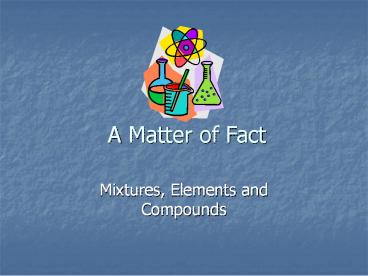A Matter of Fact PowerPoint PPT Presentation
1 / 19
Title: A Matter of Fact
1
A Matter of Fact
- Mixtures, Elements and Compounds
2
Lets see what you already knowfrom previous
lessonsDiscussion
- 1. Is air only made up of O?
- 2. What is matter?
- 3. What is mass?
- 4. What are the four states of matter?
3
Lets see how much you remembered.
- 1. No, it is also composed of other gases such
as, N,C, and other gases. - 2.Anyting that takes up space.
- 3. Amount of matter.
- 4. Solid, Liquid, Gas, and Plasma.
4
Lesson Objective
- Compose the right questions to ask when
identifying matter. - Distinguish between an element, compound, and a
mixture. - Define a heterogeneous mixture and give an
example. - Define a homogenous mixture and give an example.
5
Mixtures, elements, compounds
- All matter can be classified as mixtures,
elements and compounds.
6
First, we must understand what the terms mean
- Element- only one kind of atom.
- Ex. O- is only oxygen
- Ex. Fe- is only Iron
- Do not write question (class discussion)
- Can you think of another element that is only
made up of one atom we discussed in past lessons?
7
- Compound- is two or more different elements
combined. - Ex. H2O-Water
- Ex. NaCl-Salt (Sodium Chloride)
- Do not write question (class discussion)
- Can you think of another compound that is only
made up of two or more different elements we
discussed in past lessons?
8
- Mixture- two or more substances that are not
chemically combined with each other and can be
separated by physical means.
9
Why isnt it a good idea to classify matter by
its phases?
- Because one kind of substance can exist in more
than one phase such as H20. And matter changes
phases rather easily.
10
Why isnt matter classified according to its
physical characteristics, such as color?
- Scientists wouldnt find it very useful to group
gold, sunflowers, and the sun together.
11
Scientists ask themselves these questions?
- Is the matter uniform throughout?
- Can it be separated by physical means?
- Can it be separated by chemical means?
12
- By asking these questions scientists can classify
matter - Todays lesson will focus on classifying matter
as a mixture.
13
Is it uniform throughout?
- If the answer is no, the matter is a
heterogeneous mixture. - Does not appear to be the same throughout.
- Particles are large enough to be seen and to be
separated from the mixture.
14
Examples of heterogeneous mixtures
- Sand and pebbles
- Oil and water
- Oil and Vinegar
15
Is it uniform (even) throughout?
- If the answer is yes, the matter is homogeneous
(looks the same throughout). - That leads us to another question.
16
Can it be separated by physical means?
- If the answer is yes, the matter is a homogeneous
mixture or solution. - Ex. Sand can be physically separated from water.
17
Homogeneous Mixtures
- A mixture that appears to be the same throughout.
- The particles that make up the mixture are very
small and not easily recognizable.
18
Mini Lab Time ?
- Homogenous ????
- Materials ?????
- Heterogeneous???
- Materials????
19
Mini Lab ?
- Homogenous
- Materials
- -Water
- -Sugar
- -Salt
- -Spoon
- -Clear Cups
- Heterogeneous
- Materials
- -Water
- -Oil
- -Vinegar
- -Sand
- -Pebbles
- -Clear Cups

